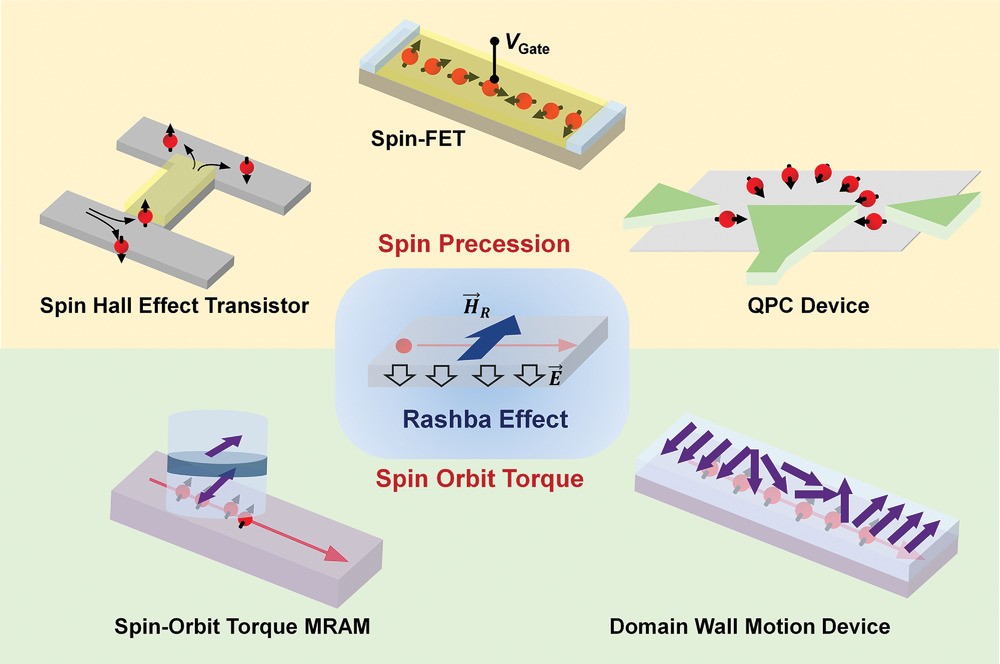
Disclaimer: Copyright infringement not intended.
Context
- A team of scientists, led by Prof. Tanusri Saha Dasgupta at the S.N. Bose National Centre for Basic Sciences, has made a significant breakthrough by computationally designing a novel composite quantum material.
- This material exhibits an exotic quantum property known as Rashba splitting on a colossal scale, particularly within a metallic environment.
- The achievement opens doors to advancements in spintronic devices such as spin transistors, spin diodes, and spin filters, which leverage electron spin for improved performance.
Details
Quantum Materials and Their Promise
- Quantum materials are characterized by unique physical properties arising from quantum effects like fluctuations, coherence, and entanglement.
- These properties, absent in the classical world, have the potential to revolutionize technologies such as quantum computing, communication, sensors, and memory devices.
- Research efforts across physics and chemistry focus on designing, characterizing, and synthesizing quantum materials to cater to modern technological needs.
The Composite Quantum Material
- The researchers focused on a 2-D material known as MXene, specifically Mo2CO2.
- They designed a new structure named "Janus" Mo2COX (after the Roman God with two faces) by replacing one oxygen atom on each of the two surfaces with halogen atoms.
- This asymmetry disrupts inversion symmetry, leading to structurally and compositionally distinct surfaces with divergent properties.
Colossal Rashba Splitting and Anomalous Hall Effect
The designed material showcased two remarkable quantum phenomena:
- Colossal Rashba Splitting: This phenomenon involves a momentum-dependent splitting of spin bands. The chosen material exhibited a substantial Rashba splitting in a metallic environment, setting it apart from typical Rashba materials that are usually semiconducting.
- Nonlinear Anomalous Hall Effect: Another quantum property observed was the anomalous Hall effect, arising from the unique velocity of electrons under the influence of a longitudinal DC electric field.
Novelty and Significance
- The discovery marks the first-ever identification of a 2-D composite quantum material that simultaneously demonstrates Rashba splitting and the anomalous Hall effect.
- This dual property enables the material's integration into spintronic devices.
- The research team also assessed the thermal and dynamical stability of the designed material, affirming its potential stability when synthesized in a laboratory setting.
Implications and Future Prospects
- The successful computational design of this 2-D composite material paves the way for overcoming challenges in large-scale manufacturing of Janus MXenes in laboratory settings.
- The newfound material's potential applications extend to various devices, promising advancements in energy security, the economy, and technology.
- The breakthrough underscores the potential of quantum materials to transform industries and catalyze technological evolution.

Rashba Splitting
- Rashba splitting is a fascinating quantum mechanical phenomenon that occurs in condensed matter systems, revealing itself through the separation of energy levels of electrons due to spin-orbit coupling.
- This intricate effect holds immense significance in understanding material properties and potential applications in emerging technologies.
Spin-Orbit Coupling
- Spin and Orbital Motion: Spin is an intrinsic property of electrons, akin to their "intrinsic angular momentum," while orbital motion relates to their motion around atomic nuclei.
- Spin-Orbit Interaction: Spin-orbit coupling emerges from the interaction between an electron's spin and its orbital motion. This interaction is influenced by the electric field created by the atomic nucleus.
Rashba Effect
- Discovery: The Rashba effect is named after its discoverer, Yuli Eliyahu Rashba, who studied the phenomenon in the context of semiconductors.
- Symmetry Breaking: Rashba splitting arises in systems lacking inversion symmetry, such as surfaces, interfaces, or strained materials.
- Asymmetry-Induced Splitting: In an asymmetric electric field, electrons experience a spin-dependent force perpendicular to their momentum, leading to energy level splitting.
Mechanisms Behind Rashba Splitting
- Structural Asymmetry: The absence of inversion symmetry results from crystal lattice deformations, surface reconstructions, or interface arrangements.
- Electric Field Gradient: An electric field gradient breaks spin degeneracy, causing energy bands to split.
- Kane-Mele Model: Theoretical models like the Kane-Mele model provide insights into topological effects contributing to Rashba splitting.
Applications and Significance
- Spintronics: Rashba splitting is integral to spintronics, where electron spin is harnessed for data storage and processing.
- Topological Insulators: Certain materials exhibiting Rashba splitting also display topological insulator behavior, enabling dissipationless transport on their surfaces.
- Quantum Computing: Rashba systems are explored for quantum bits (qubits) due to their unique spin properties.
- Photovoltaics: Understanding Rashba splitting aids the design of efficient solar cells, improving charge separation and collection.
Experimental Observations
- Angle-Resolved Photoemission Spectroscopy (ARPES): ARPES experiments provide direct insight into Rashba splitting by mapping energy-momentum dispersion of electrons.
- Surface States: Rashba splitting is often pronounced in surface states of materials.
- Quantum Wells and Heterostructures: Semiconductor heterostructures and quantum wells facilitate controlled Rashba splitting due to spatial confinement.
Challenges and Future Directions
- Engineering Control: Achieving and controlling Rashba splitting in desired materials requires precise manipulation of structural and electronic parameters.
- Quantum Interactions: Quantum interactions and disorder can modify or obscure Rashba effects, necessitating careful theoretical and experimental scrutiny.
- Beyond Rashba: Theoretical extensions explore more complex spin-orbit interactions beyond Rashba, such as Dresselhaus and Bychkov-Rashba effects.

Conclusion
Through innovative computational design, the research team has unlocked the potential of a composite quantum material to exhibit colossal Rashba splitting and anomalous Hall effects. This achievement stands as a testament to the power of interdisciplinary research, offering a glimpse into the promising future of quantum technology and its potential impact on various sectors.
|
PRACTICE QUESTION
Q. Elaborate on the significance of Rashba splitting in spintronic devices and its potential applications. How can this achievement revolutionize the landscape of quantum technology? (250 Words)
|
https://dst.gov.in/scientists-design-first-ever-2d-composite-quantum-material-useful-spintronic-devices-transistors




